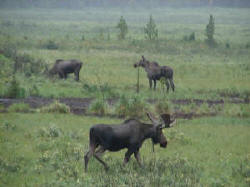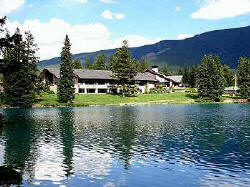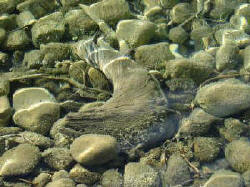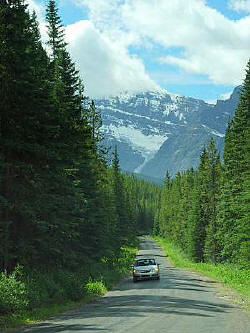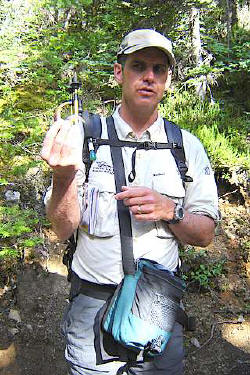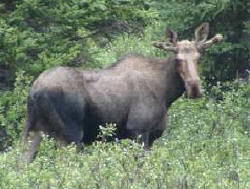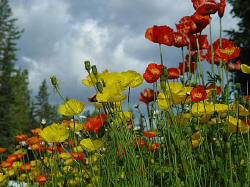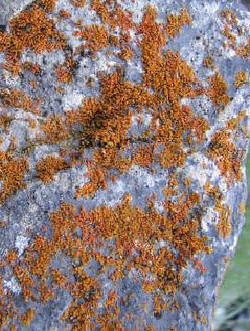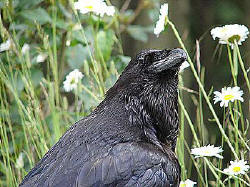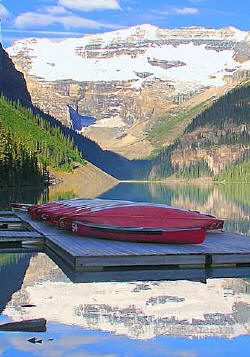Finding Wilderness in the Canadian Rockies
by Rich and Pat Middleton
Text and photos may not be reproduced or used in any format without permission of Great River Publishing.Note from the author: I hope you are enjoying these brief insights into our travels. Please be sure to read the captions associated with each photograph by placing your cursor over the photo. Do not click your mouse. In a second the caption will appear on your screen. The sport of "extreme skiing" originated in the steep mountain terrain near Lake Louise. I don't know that there is a category of "extreme travel scenics." There should be a special category for this area of the earth!
We have a poster painted by the well-known Western artist, Bev Doolittle, with the title, Wilderness! Wilderness? In it, an alpine lake in the Western Mountains reflects a beautiful wilderness scene that is missing one ingredient... the wildlife... the ripples from fish, the soaring eagle, the large mammals that populate the actual lake front.
More than once as we traversed the national parks of the Canadian Rockies, I thought of that painting. Indeed, the striking beauty of wilderness mountains, vast forest, icefields and glacier-fed lakes, rivers, and streams, in this narrow band of steeply uplifted earth is so esthetically unique that the national parks of Jasper, Banff and Yoho have been designated as a World Heritage Site by the United Nations. But juxtaposed against that compelling backdrop was the number of PEOPLE we found in all the best known destination sites.
The sidewalks in the village of Banff were crowded with roiling crowds nearly 5 across throughout the shopping area. Millions of visitors prowl through interpretive waysides and hiking areas in the three months of peak summer season travel.
"But that's not what your pictures show," viewers have written. "It looks like a deep wilderness!"And of course, it is! Indeed, amidst all this "extreme beauty" which had been highlighted to the world during the Calgary Olympics, we still found the silent wilderness, the wildlife, the natural drama of God's own pallet that we were looking for when we came to the Canadian Rockies. But, honestly, we had to search for it! And for us, it was the search that made this journey so memorable.
Our secret? Be up early. Be on task (I know, I know, this is a vacation!) Be out there. I remember a steamboat passenger one year who had complained that she hadn't seen even one of the 15 Bald Eagles we had spotted that morning..
"Well, m'am," the naturalist, suggested, "you're just going to have to go out on deck. Those eagles aren't going to fly through your cabin!"
JASPER, Alberta and Jasper National Park
From Jasper's Alpine-styled Via Rail station, our route to the Fairmont Jasper Park Lodge located along the shore of Lake Beauvert immersed us immediately into the Canada landscape we had long anticipated exploring.
Our rental vehicle would convey us through the Columbian Icefields on the spectacularly Columbian Icefields Parkway. We also planned to take occasional side trips on mountain switchbacks, through the mountain passes of Kananaski Country and finally into urban Calgary.
Our first evening, the path around Lake Beauvert at the Jasper Park Lodge was densely populated with visitors like ourselves who were seeing an alpine lake and storied mountain lodge for the first time. Without a doubt, the Canadian National Park system and the hoteliers have done as well as possible to facilitate the numbers of visitors to Banff and Jasper National Parks, but the next morning Rich and I made sure we were up early.
At that hour, there were not five other people visible in the whole vicinity of Jasper Park Lodge and Lake Beauvert! By 6 a.m. it seemed we had the whole wilderness to ourselves! But elk had already retreated from the meadows, the morning breeze was already rippling the surface of reflective lakes.
After we settled into the Fairmont Chateau Lake Louise that evening, after a day in the icefields, we planned to be up by 4:30 a.m... well before sunrise, in order to enjoy hours of scenic solitude at what is considered to be one of the top ten most beautiful natural sites in the entire world. The trails at Lake Louise were empty in the hours before 7 a.m. The famous reflective surface of Lake Louise and Emerald Lake were perfectly still.
Even GOD seemed to save his most stunning natural displays for the extreme early hours. By 6 a.m. the lights reflecting off the glacier at Lake Louise had lost the astounding glow of sunrise reflected in the mirror-like lake.
The animals knew the schedule also. Early morning was key to spotting deer, coyote, and other smaller mammals. Naturally enough, animals could be found just about anywhere but the heavily used trailheads, or the easily accessible lake or overlook. Given the crowd of humanity, easy to see why the Canada National Parks feel like they are trying to protect their little islands of wilderness from a sea of encroaching tourism!
It is first of all WATER that attracts the attention in these perpetually snow-capped mountain ranges.. Rivers flow through steep gorges. Innumerable streams, lakes, and three oceans are fed by the Columbian ice-fields protected by Jasper and Banff National Parks. .
Two different water sources feed the dramatically pristine mountain lakes and rivers. The first type is glacial meltwater. Both rivers and lakes may appear to be uniquely reflective and a milky aquamarine in color. Malign Lake seen in the photo above of Spirit Island is an example of that milky blue quality.
These waters are fed by meltwater from the glacial icefields. Our guide at Lake Louise explained that silty glacial particles about the consistency of flour trap all but the blue spectrum of light, which gives the glacial lakes their unique color.
Other mountain lakes and rivers run perfectly clear... their source is ground water, filtered through limestone in what is described as a "Karst" terrain. Lake Beauvert in Jasper Park is an example of a ground water supplied lake. Identifying these water sources as we traveled added to our sense of feeling "at home" in this grand wilderness!
For more on the Columbian Icefields, and the storied rivers that provided natives, explorers and fur traders with Canada's first travel corridors... CLICK HERE.
The existence of exposed limestone in the mountains produces one of the more fascinating oddities of the Canadian Rockies... sea shells! As the continental plates ground together in this area, the earth was forced upward in high, steep, ragged ranges... exposing limestone from an ancient sea. It is those limestone layers that release the seashells in the mountain tops as the limestone is eroded.
It is apparent to the eye that the Canadian Rockies bear little resemblance to the American Rocky Mountains in Colorado. In fact, even the Canadian ranges obviously have origins that vary, depending on whether one is looking at the jagged edges of the front ranges or the more rounded main ranges.
While the American Rockies were formed long ago by volcanic eruptions and erosion, the Canadian Rockies (which actually begin in Montana's Glacier National Park) are the result of plate tectonics.
The American Rockies are higher, but the Canadian Rockies are much more dramatic in rising directly up from the ground.... the American Rockies raise 10,000 feet in 6.5 miles, the uplift in the Canadian Rockies can be 10,000 feet in 2 1/6th mile. The Canadian mountain range is only 80 miles wide at best. Finally, while the American Rockies are largely formed of granite, there is no granite in the Canadian mountains. They are composed entirely of sedimentary rock.
Lake Louise and Banff National Park
It is large mammals that are most likely to attract the human "indicator species" along the mountain roads. We often heard reports of black bears seen scrambling across roadways. Female grizzlies and their cubs do live in the parks and are closely tracked by those responsible for the interactions of visitors and wildlife.
Bear #72 and her cubs made Lake Louise their home, and Michael Vincent, one of several hotel naturalists, gave us thorough lessons in behaviors that make bears and tourists a pretty poor bed fellows.
"Forget the tinkling 'bear bells'" he instructed us... "we locals call them 'dinner bells.' Bears simply can't hear them until you are almost on top of them. So between a hiker with ear pods and a mother bear that can't hear, we have a confrontation waiting to happen! You want them to know you are coming at least 100 feet away. They have a very large personal space bubble." Far better than bells, he suggested, to periodically let out a sharp, loud, shout of, "SCRAM BEAR!"
Bears at Banff National Park are not "muggers," we were told; though there was a time in the '70s and '80s when starving bears really were a danger to visitors. But great pains have been taken to eliminate the connection between humans and food of any sort. Current management plans call for active harassment by rangers of bears that wander too close to human concentrations.
"We want them to know that the two-legged monkeys are really nasty creatures," Mike told us. "They have no interest in being anywhere we are."Physically, the Rocky Mountain grizzlies are not as imposing as the salmon-fishing grizzlies on the west coast. According to Mike, those grizzlies can reach 1000 pounds while the mountain grizzlies weigh in at 200 to 300 pounds.
The other large mammal we were most interested in seeing was the moose. Our reward came on a rainy day while driving from Canmore (just outside of Banff) to Calgary a when we followed , a well-marked, but less traveled, route through "Kananaski" Country along the Bow River. It was one of the few rainy days we had over the course of three weeks in Western Canada, and the heat intolerant moose were out in force. Several females nonchalantly crossed highway 40, the Kananaski Trail.
Further explorations onto mountain side roads meant we stumbled onto a "lick" where as man
y as eight moose ambled about, some resting belly deep in the bog mud. And by golly, they really were "licking" it! We were told that the "licks" whether a mud lick or salt lick along the highway, attracted lots of animals from the mountains at this time of year. Females are short of minerals utilized in lactation, and the need to restore minerals used in developing winter coats meant the males were around as well.
We enjoyed seeing elk here and there in the park. The ungulates (deer, elk, goats, sheep) are browsers and about the only browsing available in the abrupt mountain ranges are in the same gentle valleys where the humans like to congregate ... near golf courses and major town sites in the mountains.
Plant life in the mountains was diverse and perfectly adapted to survive in specific environmental niches. That is always the case with life, of course, but it was so clear here... from the 53 species of liverworts, colorful lichens, tiny alpine flowers and mosses sheltering behind each rock above the tree-line.
We stopped many times to photograph the extravagant excess of the multicolored Indian paintbrush, wild blue flax, calypso, and orchids.
One interpretive sign counted 996 vascular plants and 243 mosses in the Canadian Rockies. Forests include lodgepole pine, White Spruce, Douglas Fir, and trembling aspen.
Birding in the national park was excellent. Pull-offs, interpretive waysides, and camping areas all provided many species. The Osprey at right (see chicks huddled below?) was perched in a tall tree on a steep mountainside... so it's nest appeared to be eye-level from the road!!
So were we content with the wilderness we found in the Rocky Mountains?
We would offer a resounding, YES. But we had to put on our hunting caps and try to think like the animals we were trying to spot and photograph.
For us, that's exactly where the fun began!!
For more on the Columbian Icefields, and the storied rivers that provided natives, explorers and fur traders with Canada's first travel corridors... CLICK HERE.
If you go:
Photographers, we recommend a guide that was as valuable as any "travel guide" we have ever purchased: How to Photograph the Candian Rockies by Darwin Wiggett.
Wilderness Tours In the Jasper Area
For an outstanding Wilderness experience Joyce@Do-Travel.com recommend CMH Heli-Hiking. Contact Joyce or phone 800-661-0252 or any travel agent. 2 nights ran $1874 per person thought many different packages are available.
As an alternative to Via Rail's Classic Train Journey on the Canadian, there is also a private train company operating longer tours through the mountains. Visit www.rockymountaineer.com or through a travel agent.
One of the world's most renown scenic boat cruises is the cruise to Spirit Island on Maligne Lake. Visit www.malignelake.com or arrange in advance with your travel agent.
Brewster's guided bus tours to all major sight-seeing areas are commonly available. Sign up with your travel agent or in any of the national park shopping areas or hotels.
Fairmont Jasper Park Lodge The Fairmont Chateau Lake Louise, The Fairmont Banff Springs, The Fairmont Palliser (Calgary). For reservations, visit www.fairmont.com A B&B package in the main lodge, and overlooking Lake Beauvert, Lake Louise, ran from $403 to $900 per night. Except substantially lower prices if you travel in off season. May is a beautiful month in the mountains. The waterfalls, streams, gorges are all at their most dramatic in the full flush of the spring melt.
Note regarding historic hotels mentioned on this tour: There are many comfortable hotels in fabulously beautiful locales throughout the Canadian Rocky Mountains. We found that even in the July high season, there were vacancies at each major destination. Reservations are recommended, however.
The Fairmont Hotels we visited are considered to the finest hotels of a handful of hotels in Canada, and perhaps among the top 20 in the world. We thought that each made an extra-ordinary commitment to accommodating and educating the traveler in a manner befitting not only Fairmont Hotels, but also the extra-ordinary natural setting of each of the historic hotels. In every case, the hotels put us right at the most renown natural scenic site.
Return "Via Rail Classic Canada Train Journey"
or
Return to the Waterway Cruises Directory
Click the envelope to email a comment. Did you find this story entertaining? Informative? Educational?
Coming Soon!
Continue through the Canadian Rockies on the Columbian Icefields Parkway, and the Kananaski Trail to Calgary
